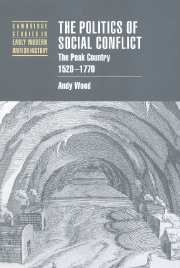Book contents
- Frontmatter
- Contents
- List of figures
- List of tables
- List of maps
- Preface
- List of abbreviations
- Introduction ‘Terms we did not understand’: landscape, place and perceptions
- 1 Social relations and popular culture in early modern England
- Part I The structures of inequality
- Part II The conditions of community
- Part III The politics of social conflict
- Bibliography
- Index
- Cambridge Studies in Early Modern British History
Introduction ‘Terms we did not understand’: landscape, place and perceptions
Published online by Cambridge University Press: 27 July 2009
- Frontmatter
- Contents
- List of figures
- List of tables
- List of maps
- Preface
- List of abbreviations
- Introduction ‘Terms we did not understand’: landscape, place and perceptions
- 1 Social relations and popular culture in early modern England
- Part I The structures of inequality
- Part II The conditions of community
- Part III The politics of social conflict
- Bibliography
- Index
- Cambridge Studies in Early Modern British History
Summary
In 1724, Daniel Defoe published an account of his recent journey through the Peak Country of north-west Derbyshire. In his mind's eye, he re-crossed the ‘black mountains’ which separated the Peak Country from its neighbours, and entered the hills and valleys of that region. Here Defoe saw again the dominant lead mining industry in its full bloom, moved through the small, compact, poverty-stricken mining villages, and encountered the ‘Peakrills’ (‘the subterranean wretches … who work in the mines’) who dwelt there. Yet for all its flair, Defoe's oft-cited responses to the Peak and its people followed a script established by earlier accounts of the place, and by the prejudices of his class. Like so many other visitors to the region, Defoe was shown its geological and architectural ‘wonders’ – the baths at Buxton, the Duke of Devonshire's great mansion at Chatsworth, the immense cave known as the Devil's Arse at Castleton – and commented upon the folk-beliefs which attached to some of these sites. In leading his readers on a journey ‘through this howling wilderness in your imagination’, Defoe knew that he was speaking to prior assumptions held by his polite, educated readership about the Peak Country in particular, and about upland, industrial areas in general.
- Type
- Chapter
- Information
- The Politics of Social ConflictThe Peak Country, 1520–1770, pp. 1 - 9Publisher: Cambridge University PressPrint publication year: 1999



